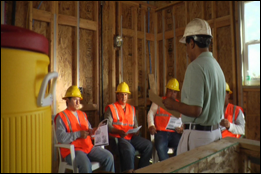Temperature Extremes
Industrial hygiene addresses a wide range of workplace hazards, including physical hazards such as temperature extremes.

These hazards can occur when workers are exposed to unusually high or low temperatures for extended periods, creating conditions that can harm their health and reduce work performance. Temperature extremes fall into two main categories: heat stress and cold stress.
Heat Stress
Heat stress occurs when the body cannot cool itself fast enough through sweating and blood flow to the skin. When heat builds up, workers may first feel thirst, fatigue, dizziness, and headache. Without prompt action, this can progress to heat rash, heat cramps, heat exhaustion, and the medical emergency heat stroke. Heat stress can happen indoors or outdoors, especially where there is high temperature, high humidity, poor air movement, or strong radiant heat from hot surfaces or equipment.
Warning signs that require immediate response include confusion, slurred speech, fainting, very hot dry skin or heavy sweating, and a rapid pulse. Workers and supervisors must act at once to cool the person and call for medical help if heat stroke is suspected.
Such places include: iron and steel foundries, nonferrous foundries, brick-firing and ceramic plants, glass products facilities, rubber products factories, electrical utilities (particularly boiler rooms), bakeries, confectioneries, commercial kitchens, laundries, food canneries, chemical plants, mining sites, smelters, and steam tunnels.
Outdoor operations conducted in hot weather, such as construction, refining, asbestos removal, and hazardous waste site activities, especially those that require workers to wear semipermeable or impermeable protective clothing, are also likely to cause heat stress among exposed workers.
Hazards
- Roofing, road paving, and concrete work expose crews to direct sun, hot surfaces, and limited shade, which can raise body temperature quickly during midday.
- Employees work near furnaces and molten metal, where radiant heat combines with high air temperatures to create extreme heat exposure. Heavy protective gear can also limit cooling.
- Cooks, bakers, and food service workers face constant heat from ovens, stoves, fryers, and dishwashers, with limited airflow to remove the heat.
Controls
- Use ventilation systems, spot cooling fans, or air conditioning in hot areas. Add reflective shields or barriers to reduce radiant heat exposure.
- Schedule work during cooler hours, rotate workers to limit exposure, provide shaded or cooled rest areas, and require frequent hydration breaks.
- Provide cooling vests, breathable clothing, and wide-brimmed hats for outdoor work. Use light-colored fabrics to reflect sunlight where possible.
- Reduce the physical demands of work, e.g., excessive lifting or digging with heavy objects
- Assign extra workers and limit worker occupancy, or the number of workers present, especially in confined or enclosed spaces
Knowledge Check Choose the best answer for the question.
5-9. What kind of protective clothing might cause heat stress while working outdoors?
You forgot to answer the question!
